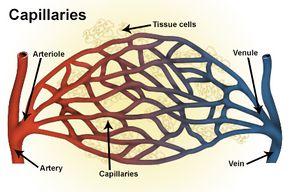Venule
Small blood vessel in the microcirculation that allows blood to return from the capillary beds to the larger blood vessels
Venule[edit]
A venule is a small blood vessel in the circulatory system that allows blood to return from the capillary beds to the larger blood vessels, such as veins. Venules are an integral part of the microcirculation, which is the circulation of blood in the smallest blood vessels, including capillaries, venules, and arterioles.
Structure[edit]

Venules are formed when capillaries come together. They are small in diameter, typically ranging from 7 to 50 micrometers. The walls of venules are composed of three layers, similar to larger veins, but they are much thinner. These layers include:
- The tunica intima, which is the innermost layer and consists of a thin layer of endothelial cells.
- The tunica media, which is the middle layer and contains a small amount of smooth muscle.
- The tunica externa (or adventitia), which is the outermost layer and is made up of connective tissue.
Function[edit]
Venules play a crucial role in the circulatory system by collecting blood from the capillary beds and transporting it to the larger veins. This process is essential for the return of deoxygenated blood to the heart. Venules also participate in the exchange of nutrients and waste products between the blood and surrounding tissues, although this function is primarily carried out by capillaries.
Clinical significance[edit]
Venules can be involved in various medical conditions. For example, inflammation can cause venules to become more permeable, leading to the leakage of fluid and proteins into surrounding tissues, a process known as edema. Additionally, venules can be affected by vasculitis, which is the inflammation of blood vessels, potentially leading to damage and impaired blood flow.
Related pages[edit]
Ad. Transform your life with W8MD's Budget GLP-1 injections from $75


W8MD offers a medical weight loss program to lose weight in Philadelphia. Our physician-supervised medical weight loss provides:
- Weight loss injections in NYC (generic and brand names):
- Zepbound / Mounjaro, Wegovy / Ozempic, Saxenda
- Most insurances accepted or discounted self-pay rates. We will obtain insurance prior authorizations if needed.
- Generic GLP1 weight loss injections from $75 for the starting dose.
- Also offer prescription weight loss medications including Phentermine, Qsymia, Diethylpropion, Contrave etc.
NYC weight loss doctor appointmentsNYC weight loss doctor appointments
Start your NYC weight loss journey today at our NYC medical weight loss and Philadelphia medical weight loss clinics.
- Call 718-946-5500 to lose weight in NYC or for medical weight loss in Philadelphia 215-676-2334.
- Tags:NYC medical weight loss, Philadelphia lose weight Zepbound NYC, Budget GLP1 weight loss injections, Wegovy Philadelphia, Wegovy NYC, Philadelphia medical weight loss, Brookly weight loss and Wegovy NYC
|
WikiMD's Wellness Encyclopedia |
| Let Food Be Thy Medicine Medicine Thy Food - Hippocrates |
Medical Disclaimer: WikiMD is not a substitute for professional medical advice. The information on WikiMD is provided as an information resource only, may be incorrect, outdated or misleading, and is not to be used or relied on for any diagnostic or treatment purposes. Please consult your health care provider before making any healthcare decisions or for guidance about a specific medical condition. WikiMD expressly disclaims responsibility, and shall have no liability, for any damages, loss, injury, or liability whatsoever suffered as a result of your reliance on the information contained in this site. By visiting this site you agree to the foregoing terms and conditions, which may from time to time be changed or supplemented by WikiMD. If you do not agree to the foregoing terms and conditions, you should not enter or use this site. See full disclaimer.
Credits:Most images are courtesy of Wikimedia commons, and templates, categories Wikipedia, licensed under CC BY SA or similar.
Translate this page: - East Asian
中文,
日本,
한국어,
South Asian
हिन्दी,
தமிழ்,
తెలుగు,
Urdu,
ಕನ್ನಡ,
Southeast Asian
Indonesian,
Vietnamese,
Thai,
မြန်မာဘာသာ,
বাংলা
European
español,
Deutsch,
français,
Greek,
português do Brasil,
polski,
română,
русский,
Nederlands,
norsk,
svenska,
suomi,
Italian
Middle Eastern & African
عربى,
Turkish,
Persian,
Hebrew,
Afrikaans,
isiZulu,
Kiswahili,
Other
Bulgarian,
Hungarian,
Czech,
Swedish,
മലയാളം,
मराठी,
ਪੰਜਾਬੀ,
ગુજરાતી,
Portuguese,
Ukrainian